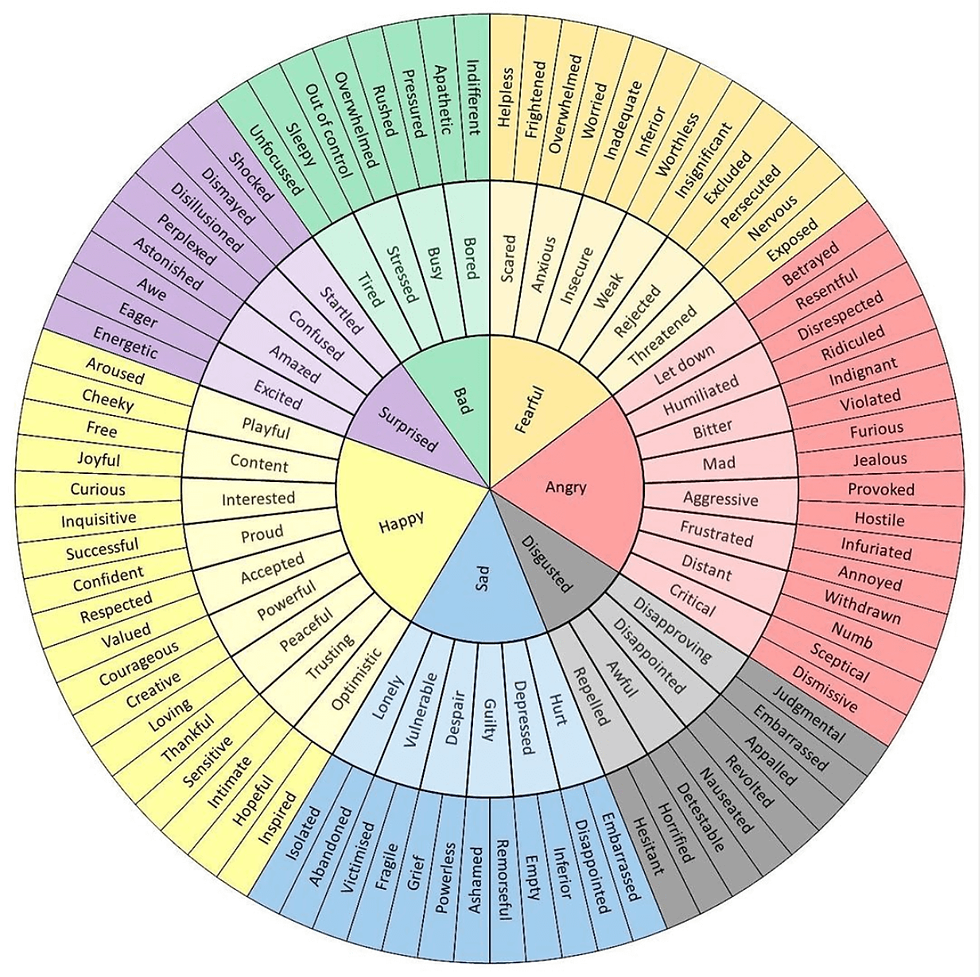Emotional vocabulary: To convey what I feel, I need the right words!
- Shruti Ganesh

- May 17, 2023
- 4 min read

We all have our names. We use names to identify each other. Have you ever wondered if we did not have names? What would happen? If we did not have names, it would be so hard to approach a person specifically, to talk to or ask for help or appreciate them. It is so important to identify a person in the first place to understand their stories in life. Imagine how confusing it would become if the people in our lives did not have names, it would be so confusing to talk about who did what or who said what.
If we look back at human history, we understand the importance of naming to identify great personalities. Similarly, it is important to name our emotions to identify what we are feeling. Emotional vocabulary can be explained as the particular words used for the particular emotion an individual is feeling. Some of the most common words used in emotional vocabulary are sad, happy, fear, surprise, bad and angry. The words used for labelling emotions differ from culture to culture (Semeraro, 2021).
Note
A lot of times, we confuse our thoughts as feelings.
Example- “I feel they dislike me”
Though one says, “I feel”, the above example is a thought and not an emotion.
Example - “I feel sad about them disliking me”
Here, the emotional vocabulary used is ’sad’. This is a clear emotion, the person is feeling and is not a thought.

Emotional vocabulary helps the individual differentiate between similar emotions. This is associated with positive mental health as it aids other capacities such as identification, regulation and expression of emotions (Vine, 2020). Emotional vocabulary is related to emotional competence (the ability to comprehend, recognise and react in emotional states) (Dylman, 2020).
The better an individual is able to identify their emotion, so is their ability to have control over one’s own emotional state (Gettenberg, 2022).
Labelling emotions allows for a blurry picture to become clearer. For example, after a fight sometimes we can be left with so many intense feelings. We often assume we are angry. But if one takes the time to sit and label the emotion, we might find other emotions below the anger and feelings of hurt, sadness, disappointment or guilt. When we accurately label what is happening, that emotion can inform our future steps. Do we just want to cope with that emotion (listen to music, scribble, punch a pillow?) Do we want to express it (make a journal entry, cry it out, tell someone else what happened)? Does our emotion feel steady enough that maybe we can assertively communicate and problem solve?
Pro tip
When trying to convey your needs, use this non-blaming framework
I feel ____ (emotion word) when you ____ (specific action) and I would appreciate if you ______ (alternative action)
For example,
I felt hurt when you ignored my opinion in the team meeting and I would appreciate it if next time you take some time to consider my points.
A strong emotional vocabulary and the labelling helps us address the problem at hand. Many individuals do not process emotions, choosing to avoid or dismiss them. Yet encouraging the categorising and labelling of emotions can initiate the process of regulation which may not automatically happen to such individuals.
How do we build our emotional vocabulary?
Now that we know the value of having an emotional vocabulary, you may be wondering how one can efficiently build a broad treasure trove of expressions.
Tip 1: Consider your physical sensations
Though the term emotional vocabulary focuses on the ‘labels’ or ‘words’ used to identify an emotion, it could be more than just words.For example, I may say “I am feeling sad” whereas someone else feeling the same emotion might just say, ”I am not feeling that great, everything feels heavy”. Physical sensations, gestures, and other nonverbal components can inform the depth and intensity of emotions and hence lead to a better descriptions of your emotional landscape
Tip 2: Use what words and language works for you
Though people in Mumbai and Uttar Pradesh speak Hindi, the same language, the way it is spoken still differs. Similarly, all of us might be speaking the same language, but our vocabulary for our own emotions could be different. Hence it is important to look beyond the common words/labels used for particular emotions and identify one's own labels/words one uses for one’s own emotions. Emotional vocabulary can be in any language of one’s own comfort.
Tip 3: Reading, emotion charts
Reading habits are related to efficient emotional vocabulary as well (Dylman, 2020). Reading exposes people to different emotional words as well as allows you to be part of characters' journeys as they navigate emotions. It may aid in your ability to empathise and understand other individuals' emotions better.
Different charts, images can also be a pathway to learn. Plutchik’s emotional wheel has been presented below. It is a great source to learn emotion labels and strengthen emotional vocabulary.

Given below is a list of words from emotional vocabulary in Hindi.
Source: Pinterest

Such simple strategies to develop emotional vocabulary would contribute to an overall emotional well being through improving emotion regulation and competence.
Kindly fill the feedback form for this blogpost here, it would be helpful!



Comments